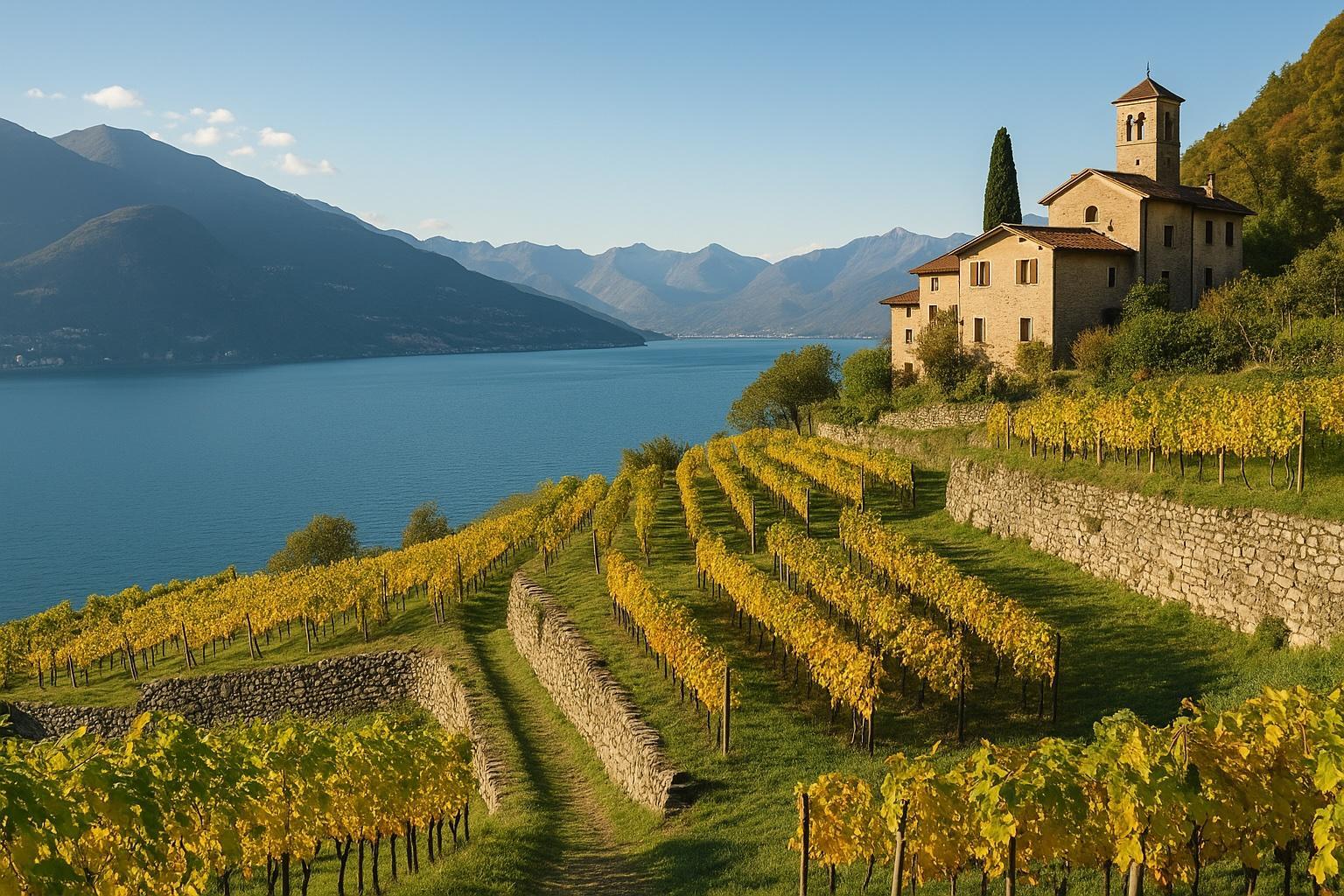Autumn has a way of slowing time around Lake Como. The light turns warmer, the air carries a sharper edge, and the slopes that descend toward the water dress themselves in shades of gold and rust. It is the perfect season to leave behind the busy promenades and explore the hidden side of the lake: its vines, stone walls, and the hamlets that lie quietly between them. These walks are not about reaching a destination quickly but about letting the rhythm of the season guide each step.
A landscape shaped by stone and vine
The hills above the lake have always been worked by human hands. For centuries, farmers carved terraces into steep slopes, supporting them with dry-stone walls that still stand today. Between these walls, vines were planted, their roots gripping the earth, their leaves now shimmering in autumn colors. Walking among them, one senses both the effort and the beauty of a landscape that is both natural and built. The walls curve with the land, creating patterns that catch the light at different hours of the day. To follow these paths is to walk inside a living architecture.
The quiet charm of hidden hamlets
Nestled among vineyards and olive groves are hamlets that many visitors never see. They are not on postcards or guidebook covers, but they hold the soul of the lake. Narrow cobbled streets, archways, tiny squares where old fountains still trickle: these are places where life moves slowly, where neighbors still greet each other by name. In autumn, smoke curls from chimneys, doors are left open to cool kitchens after long days of preserving fruit and pressing grapes. Passing through, one hears footsteps echo off stone and the occasional toll of a bell from a small church.
Traditions of the season
Autumn is also the season of traditions. In some hamlets, the grape harvest still follows rhythms set generations ago. Families gather to pick clusters by hand, pressing them in small cellars where the scent of must fills the air. Olive groves, too, come alive, with nets spread beneath branches and baskets filling with green and black fruit destined to become golden oil. Local festivals celebrate these labors with chestnuts roasted in the square, new wine poured freely, and music that carries through the night. To stumble upon such a gathering while walking is to glimpse the lake’s living heritage.
The rhythm of the walk
What makes these walks special is their pace. Unlike the ferries or busy lakeside streets, the paths between vines and walls invite slowness. Each step reveals a new angle of the lake—sometimes a glimpse of water between branches, sometimes a sudden, sweeping view as the path opens onto a terrace. The soundscape changes, too: the crunch of leaves underfoot, the rustle of wind in dry vines, the occasional bark of a dog from a distant courtyard. It is a rhythm that encourages reflection, as if the path itself were guiding the walker to look closer, listen deeper.
Unexpected panoramas
Hidden among these routes are viewpoints that rival the most famous spots. A stone wall might suddenly end, opening onto a panorama where the lake lies like a mirror, framed by vines glowing in the afternoon light. From some terraces above Menaggio or Bellagio, the three branches of the lake spread out in view, while the peaks of the Grigne and Legnone already wear dustings of snow. In Valtellina, the vineyards that line the hillsides give way to wide horizons, where the Adda River winds down toward the lake. These perspectives are not crowded; often one stands alone, sharing the moment only with the silence.
Stone as memory
The dry-stone walls themselves are more than boundaries. They are memory carved into the land. Built without mortar, stone upon stone, they represent centuries of skill and patience. Many are centuries old, yet they still hold the soil, vines, and paths with quiet strength. To run a hand across their surfaces is to touch history, the same stones placed by farmers who looked upon the same lake with hopes not so different from ours today. Their endurance is part of the beauty of the walks, reminders that the landscape is a dialogue between nature and human effort.
Hamlets of authenticity
Among the most evocative hamlets are those that seem frozen in time. Small villages above Domaso or along the road to Nesso reveal clusters of stone houses, with wooden balconies draped in drying herbs and narrow alleys where cats wander freely. Some have tiny chapels decorated with frescoes faded but still vibrant in spirit. In autumn twilight, when the sun sets early behind the mountains, these places glow softly, lanterns appearing one by one, voices rising from kitchens preparing polenta and stews. They are moments when the visitor feels not like a tourist but like a guest passing through a story.
A journey into slowness
To walk between vines and stone walls in autumn is not simply an excursion but a way of entering the deeper rhythm of Lake Como. It is to see the lake not only as a destination but as a landscape still tied to labor, tradition, and memory. The hamlets and paths invite curiosity but also respect: these are lived-in places, where time is measured not by schedules but by seasons.
The poetry of the season
As the day ends, the light softens and the lake below shifts color from blue to silver. The walls grow darker, the vines release their last glimmer of gold, and the hamlets prepare for night. For the walker, the experience lingers. Autumn on Lake Como is not only about what is seen but about what is felt: the silence of stone, the warmth of tradition, the beauty of views discovered step by step.




